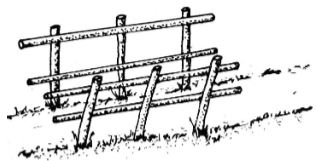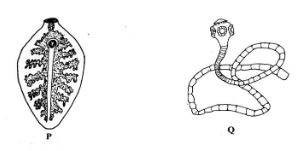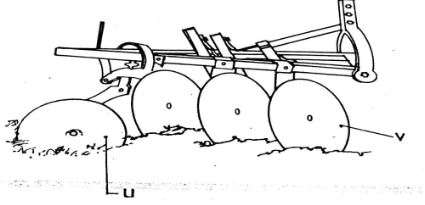Instructions to Candidates
- The paper consists of the three sections A, B and C.
- Answer all questions in section A and B
- Answer any two questions in section C.
SECTION A: (30 MARKS)
- State four importance of keeping livestock healthy. (2marks)
- State four symptoms of Rinderpest attack on animals. (2marks)
- State three observable features that help differentiate the Dromedary Camel from the Bacterian Camel. (1½ marks)
- Functions of crop in digestive system of a chicken. (2marks)
-
- Give three reasons for candling eggs in poultry production. (1½ marks)
- State three qualities of the shell that should be considered when selecting eggs for incubation. (1½ marks)
- State two causes of bad flavor in milk. (1mark)
- State four structural features of ideal calf pen. (2marks)
- Give the functions of the following tools and equipment. (2marks)
- Sickle
- Strip cup
- Claw hummer
- Mason’s trowel
- Name four farm implements attached to power take off. (2marks)
- List three zoonotic diseases that can occur in the farm. (1½ marks)
- State four signs of heat in pigs. (2marks)
- Give four factors that affect digestibility of feeds in animals. (2marks)
- Name two advantages of zero-grazing as a method of rearing farm animals. (1mark)
- Give three ways in which farmers market beef cattle in Kenya. (1½ marks)
- Differentiate between roughages and concentrates. (1mark)
- Outline four farm structures that are necessary for handling dairy animals. (2marks)
- State three sources of farm power. (1½ marks)
SECTION B: (20 MARKS)
Answer all questions in this section in the spacesprovided.
- The diagram below illustrates a livestock handling structure
- Identify the structure (1 Mark)
- Name any four practices that a farmer can carry out in the structure (4 Marks)
- Below are illustrations of farm tools labelled A, B, C and D
- Identify the tool/ equipment labeled A and B (2 Marks)
- State one appropriate use of the tool labeled D. (1 Mark)
- Explain two maintenance practices for the tool labelled C. (2 Marks)
- Given below are illustrations of two adult internal parasites of sheep labelled P and Q
- Identify the parasites (2 Marks)
P
Q - In which organs in livestock are parasite P and Q found? (2 Marks)
- How should sheep suffering from parasite Q infestation be treated (1 Mark)
- Identify the parasites (2 Marks)
- The diagram below represents an implement
- Identify the equipment (1 Mark)
- Name the parts labelled U and V and give one function of each (2 Marks)
- State four maintenance practices carried out on the implement shown in the diagram(2 Marks)
SECTION C: (40 MARKS)
Answer any two questions on the spaces provided
-
- Describe the management of one day old chick in a brooder until they are eight weeks. (12marks)
- State the uses of fences in farms. (8marks)
-
- Describe the factors considered when culling livestock. (5 Marks)
- Describe five factors that affect milk composition in dairy farming. (5 Marks)
- Explain measures used to control livestock diseases. (10 Marks)
-
- Discuss Foot and Mouth disease under the following headings:
- Casual organisms. (1 Mark)
- Livestock species attacked. (2 Marks)
- Symptoms of attack. (4 Marks)
- Describe digestion of grass in small intestines of ruminant animals (5 Marks)
- Causes of cannibalism in poultry. (8 marks)
- Discuss Foot and Mouth disease under the following headings:
MARKING SCHEME
- Importance’s of keeping animals health.
- Healthy animal grows well and fast enough to reach maturity.
- Good health gives animals a longer economic and productive life.
- Healthy animals gives maximum production or performance.
- Healthy animals produce good quality product.
- Healthy animal are economical and easy to keep.
- Healthy animals will not spread diseases to either animals or human beings. Mark first four points 4 x ½ = 2mks
-
-
- Crutching – This is practice of dipping or cutting wool around the vulva of ewe’s.
- Ringing – this is the process of trimming, dipping or cutting wool around the sheath of the penis in rams.
Correct definition = 2 x 1 = 2mks
-
- Steaming up – This the provision of extra feeds of high nutritive value to an animal during the last weeks of gestation.
- Flushing – feeding of female livestock with high quality feeds around service time.
Correct definition 2 x 1 = 2mks
-
- Features that help in differentiating the dromedary camel from Bactrian camel.
- Dromedary has one hump while Bactrian has two humps.
- Dromedary has less hair on its body while Bactrian has more hair.
- Dromedary has long legs while Bactrian has short compact legs. 3 x ½ = 1 ½ mks
- Functions of crop in digestive system of a chicken.
- Softening/moistening of food
- Storage of food 1 x 1 = 1mk
-
- Reasons for candling egg in poultry production.
- Determine freshness
- Detect abnormalities
- Confirmation of chick development
- Qualities of shell to be considered
- Texture/smoothness of the shell
- Absence of cracks in the shell
- Cleanliness/absence of blood stains
- Oval in shape 3 x ½ = 1 ½ mks
- Reasons for candling egg in poultry production.
- Pre – disposing factors of mastitis.
- Age – should be older animals rej. Young animals.
- Stage of lactation period
- Udder attachment
- Incomplete milking
- Mechanical injuries
- Poor sanitation
- Poor milking technique
Mark first four point 4 x ½ mks = 2mks
- Structural features of ideal calf pen.
- Concrete floors
- Adequate space
- Single housing
- Proper lighting
- Proper drainage
- Draught free
- Leak proof roof
- Functions of following farm tools and equipment
- Sickle
- for cutting back pyrethrum stalk.harvesting rice and other grasses.
- Strip cup - For checking mastitis in milk.
- Claw hammer
- used for driving and removing nails from wood.
- used in straightening nails when bent.
- Mason’s trowel
- for placing mortar between construction stones and bricks. 4 x ½ = 2mks
- Sickle
- Implements that are attached to power take off shaft.
- Mowers
- Planters
- Rotavators
- Water pumps
- Boom sprayers
- Grinding machine
- Maize shelters
- Fertilizer spreaders Mark first four points 4 x ½ = (2mks
Mark first four points 4 x ½ = 2mksMechanical methods of controlling ticks.
- Mowers
- List three zoonotic diseases that can occur in the farm.
- Salmonellosis
- Q Fever
- Brucellosis
- State four signs of heat in pigs.
- Swelling and Redness
- Restlessness
- Vocalization
- Stance and Reflex
- Factors affecting digestibility.
- Chemical composition of the feed.
- The form in which the feed is offered to the animal.
- The species of the animals.
- The ratio of energy to protein will affect digestibility.
- The quantity of feed already present in digestive systems of an animals. 4 x ½ = 2mks
- Two advantages of zero-grazing
- Increased Productivity
- Disease Control
- Ways of marketing beef cattle in Kenya.
- Kenya meat commission.
- Livestock marketing division, ministry of livestock development
- local slaughter houses/butcheries
- licensed stock traders 3 x ½ = 1 ½ mks Mark first three points
- Differentiate between roughages and concentrates.
- Roughages are characterized by high fiber, low energy, and protein content and are essential for maintaining digestive health, while concentrates are energy-dense and protein-rich feeds used to meet the increased nutritional demands of high-performing animals.
- Farm structures necessary when handling dairy animals.
- Crushes
- Cattle sheds
- Calf pens
- Milking shed
- State three sources of farm power.
- Human power
- Mechanical power
- Animal power
SECTION B (20 marks)
Answer all questions in this section in the spaces provided
- The diagram below illustrates a livestock handling structure
- Identify the structure (1 Mark)
- Crush
- Name any four practices that a farmer can carry out in the structure (4 Marks)
- spraying livestock against external parasites
- identification
- vaccination
- administering prophylactic drugs to the animals
- treating sick animals
- dehorning
- pregnancy test
- artificial insemination
- taking body temperatures
- hoof trimming
- milking
- Identify the structure (1 Mark)
- farm tools labelled A, B, C and D
- Identify the tool/ equipment labeled A and B (2 Marks)
- Hack saw
- Elastrator
- State one appropriate use of the tool labeled D. (1 Mark)
- Collecting trash
- levelling a nursery bed
- Explain two maintenance practices for the tool labelled C. (2 Marks)
- Apply oil/paint ot prevent rusting
- Grease the moving part to reduce friction
- Identify the tool/ equipment labeled A and B (2 Marks)
- Given below are illustrations of two adult internal parasites of sheep labelled P and Q
- Identify the parasites (2 Marks)
- P - Liver fluke/ Fasciola spp
- Q - Tapeworm/ Taenia spp
- In which organs in livestock are parasite P and Q found? (2 Marks)
- P - Bile duct/liver
- Q - Small intestines
- How should sheep suffering from parasite Q infestation be treated (1 Mark)
- Deworming/ drenching with appropriate anthelminthics
- Identify the parasites (2 Marks)
- The diagram below represents an implement
- Identify the implement (1 Mark)
- Disc plough
- Name the parts labelled U and V and give one function of each (2 Marks)
Name of part Function U Furrow/ rear thrust wheel Balances the plough by resisting side thrust
from the unploughed landV Concave plain Cut, turn and invert furrow slices -
State four maintenance practices carried out on the implement shown in the diagram(2 Marks)
- Clean after work
- Storing under shed
- Tighten loose nuts and bolts
- Replacing worn- out parts
- Repair broken parts
- Greasing moving parts
- Apply Oil/ painting for long storage
- Identify the implement (1 Mark)
SECTION C: (40MKS)
-
- Management of one day old chicks in a brooder until they are eight weeks.
- Provide enough and clean water all the time.
- Maintain a high degree of hygiene in the brooder e.g clean feed troughs.
- Remove the newspapers after the chicks have learnt feeding from the troughs.
- Provide enough and clean chick mash from day 1 up to 8 weeks.
- Incorporate grit on the 6th week.
- On the 7th week, introduce growers mash in the ratio of ¼ growers mash: ¾ chick mash.
- Feed on growers mash only from the 9th week.
- Place a foot bath containing disinfectant solution at the entrance of the brooder house.
- Maintain brooder temperature as follows:
- Week 1 33 – 35°C.
- Week 2 30 – 32°C
- Week 3 27 – 29°C
- Week 4 24 – 26°C
- Withdraw artificial heating after week 4.
- Vaccinate against disease like Newcastle.
- Incorporate antibiotics and coccidiostats in feeds and water to control diseases.
- Provide a wire guard around the heat sources so that the chicks are not burnt.
- Apply insecticide dust on the floor against external parasites. For external parasites like fleas attack combs, wattles, shanks and toes,
- smear petroleum jelly on them so that they suffocate and die.
- Incorporate de – wormers in water to control internal parasites.
- Isolates and treat the sick birds.
- Maintain proper ventilation all the time.
- Expand the brooder area after every 5 days to accommodate the growing chicks.
- Carry de – breaking 9 days to the end of brooding to control cannibalism.
- Keep appropriates records.
- Dispose off dead chicks well.
- Avoid damp conditions which would expose the chicks to pneumonia through provision of enough ventilation.
- Ensure that the brooder is dimly lit to avoid toe pecking and cannibalism.
12 x 1 = 12mks Mark any twelve points
- State the uses of fences in farms.
- Provide security from thieves, predators
- Enable paddocking/ rotational grazing/ mixed farming
- Control parasites and diseases by keeping away foreign animals
- Show boundaries between farms
- Hedges act as wind breaks/ conserve soil and water/ source of fruits/ fodder/firewood
- Have an aesthetic value
- Provides privacy
- Enables isolation of animals for different purposes
- Add value to the farm
- Prevents formation of unnecessary paths within the farm
- Management of one day old chicks in a brooder until they are eight weeks.
- Describe the factors considered when culling livestock. (5 Marks)
- Poor health;
- Old age;
- Physical deformities;
- Hereditary defects;
- Infertility;
- Poor mothering ability
- Poor quality products;
- Low production;
- Bad temperament.
- Describe five factors that affect milk composition in dairy farming. (5 Marks)
- Age of the animal. - Butter fat reduces as the animal gets old thus young animals produce milk with higher butter fat than old animals.
- Breed. - Different breeds produce milk with differing percentages eg Jersey produce higher B/F content than Friesian.
- Type of food eaten by the animal - Roughage produce milk with higher fat, lactose and protein than that produced from grains.
- Diseases.- Diseases like mastitis reduces the lactose composition since bacteria attack milk sugars.
- Physiological condition of the animal - Sickly/ extremely emaciated animals register low % B/F/ late pregnancy gives low B/F content.
- Stage of lactation. - Early and late stages of lactation yield milk with low B/F content than the middle stage.
- Time of milking - Milk produced in the morning has higher B/F content than milk produced in the evening.
- Season of the year - Cold season yields milk with a higher B/F content.
- Completeness of milking.- Milk drawn last from the udder during milking has more B/F content. (any 5x 1 =5 marks)
- Explain measures used to control livestock diseases.
- General farm hygiene/ cleanliness of houses to avoid predisposing causes of diseases
- proper carcass disposal; to destroy pathogens
- Isolation; prevents spread of the diseases
- Deworming; to control internal parasites
- Treat sick animals; prevent spread of the diseases
- Vaccination; develop resistance against diseases by boosting immunity.
- Control vectors; prevent transmission of diseases
- Prophylaxis; avoids infection
- Slaughtering en- mass; prevent spread of diseases
- Proper breeding; control breeding diseases
- Quarantine; prevent spread of the diseases
- Hoof trimming; minimize occurrence of foot rot
- Proper housing; avoid predisposing causes of diseases
-
Proper nutrition: prevent nutritional disorders/ boost immunity (any 10x 1 =10 marks)
- Describe the factors considered when culling livestock. (5 Marks)
-
- Discuss Foot and Mouth disease under the following headings:
- Casual organisms. (1 Mark)
- Virus/ virus types O, A, C/ south African types SAT1, SAT2, SAT3, / Asian type 1 (1x 1 =1 mark)
- Livestock species attacked. (2 Marks)
- Cattle
- Pigs
- Goats
- Sheep
- Symptoms of attack. (4 Marks)
- Profuse salivation
- Blisters which are painful around the mouth and hooves of the feet leading to lameness
- Drop in milk production in lactating cows
- Sharp rise in temperature/ high fever
- Emaciation
- Complete loss of appetite
- Diarrhea
- Casual organisms. (1 Mark)
- Describe digestion of grass in small intestines of ruminant animals (5 Marks)
- In the duodenum food is mixed with bile and pancreatic juice (pancreatic amylase, lipase and trypsin)
- Bile emulsifies fats to increase the surface area for enzyme action; bile has salt to neutralize acid from stomach;
- Pancreatic amylase converts starch to maltose
- Trypsin converts proteins to peptones and peptides
- In the rest of small intestines, food is mixed with intestinal juice/ erepsin/peptidase, Maltase, sucrose/invertase & lactase enzymes)
- Sucrase (invertase) converts sucrose to glucose
- digested food material is absorbed in the ileum (any 5x 1 =5 marks)
- Causes of cannibalism in poultry. (8 marks)
- External parasites – This may cause cannibalism in that the birds may want to remove parasites like flea from combs of others.In doing so there may be an injury that results in blood coming out of the wound. This makes bird’s peck on the wound.
- Overcrowding – this makes birds see others closely and its easy for them to detect something to peck at.
- Prolapse – This occurs when the cloaca does not retreat after the hen has laid egg. The cloaca is pecked at by others.
- Bright light – this makes the toes of chick shine, resulting in toe – pecking.
- Mineral deficiency – unbalanced feeds makes birds to try getting mineral elsewhere.
- Introduction of a new bird in a flock. This causes fighting resulting in cannibalism after an injury.
1 mark stating 1 mark explaining 4 x 2 = 8mks
- Discuss Foot and Mouth disease under the following headings:
Download Agriculture Paper 2 Questions and Answers - Samia Joint Mock Examination 2023.
Tap Here to Download for 50/-
Get on WhatsApp for 50/-
Why download?
- ✔ To read offline at any time.
- ✔ To Print at your convenience
- ✔ Share Easily with Friends / Students




